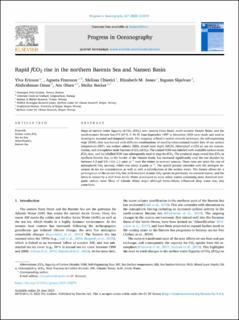Rapid fCO2 rise in the northern Barents Sea and Nansen Basin
Ericson, Ylva; Fransson, Agneta; Chierici, Melissa; Jones, Elizabeth Marie; Skjelvan, Ingunn; Omar, Abdirahman; Olsen, Are; Becker, Meike
Peer reviewed, Journal article
Published version
Permanent lenke
https://hdl.handle.net/11250/3087903Utgivelsesdato
2023Metadata
Vis full innførselSamlinger
- Articles [3012]
- Publikasjoner fra CRIStin [3066]
Sammendrag
Maps of surface water fugacity of CO2 (fCO2) over eastern Fram Strait, south-western Nansen Basin, and the north-western Barents Sea (73–84°N, 5–46°E) from September 1997 to December 2020 were made and used to investigate seasonal and temporal trends. The mapping utilized a neural network technique, the self-organizing map (SOM), that was trained with different combinations of satellite/observational/model data of sea surface temperature (SST), sea surface salinity (SSS), mixed layer depth (MLD), chlorophyll a (Chl a), sea ice concentration, and atmospheric mole fraction of CO2 (xCO2). The trained SOM was labelled with available surface ocean fCO2 data, and the labelled SOM was subsequently used to map the fCO2. The produced maps reveal that fCO2 in northern Barents Sea, at the border of the Nansen Basin, has increased significantly over the last decades by between 4.2 and 5.5 ± 0.6–1.1 µatm yr−1 over the winter to summer seasons. These rates are twice the rate of atmospheric CO2 increase, which was about 2 µatm yr−1. The spatial pattern coincides with the strongest decreases in sea ice concentration as well as with a salinification of the surface water. The former allows for a prolongation of the air-sea CO2 flux with resultant oceanic CO2 uptake in previously ice-covered waters, and the latter is caused by a shift from Arctic Water dominance to more saline waters containing more dissolved inorganic carbon, most likely of Atlantic Water origin although brine-release influenced deep water may also contribute.
